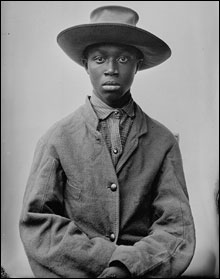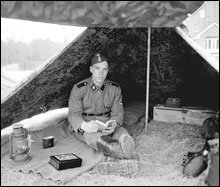 Being there fascinates us. We like to watch even if we don’t participate, we are reminded by “States of Siege: A Consideration of Re-enactment Photography,” at the University of Rhode Island Main Gallery through March 12.
Being there fascinates us. We like to watch even if we don’t participate, we are reminded by “States of Siege: A Consideration of Re-enactment Photography,” at the University of Rhode Island Main Gallery through March 12.
The Civil War is the most common setting for re-enactments and nearly the exclusive subject here by most of the six photographers, one painter. and one printmaker. Most of these are not merely documentary presentations, as the opportunity would suggest, but go on to make their own comments on reproducing reproductions. What could be more post-modern in the first place than men putting on period uniforms and appropriating history — which itself is a simulation of reality, after all?
This show, curated by Judith Tolnick Champa, certainly has plenty of soldiers in gray and blue. But that is a sort of default reference, the visual field for the more interesting figures to pop out of. One of the most intriguing presentations here doesn’t even contain people. The grisaille paintings of Don Pollack — done in black, white, and gray oils — comprise an exhibition within the exhibition, titled “South of Tennessee, Remains of the Campaign.” A steeple-less clapboard church in New Hope, Georgia, looks nondescript but was the starting place of an 1864 battle that General Sherman lost. Like tourists snapping pictures, we peer over a wrought-iron fence toward a ridge line that (we learn from the title card) provided natural concealment for the Union’s Army of the Tennessee. In another scene, camera lens flare is simulated as we view a peaceful Atlanta park, which contrasts with accompanying information about the Civil War devastation of the city.
The most explicit references to fatal subject matter here are the death masks of Damon Sauer, which started out from archived post-mortem photographs. Using a silkscreen and charcoal rubbing technique, he gets a dreamy softness to these hovering, closed-eye faces, which bridge time by depicting not only Civil War dead but also such figures as Lee Harvey Oswald and Martin Luther King Jr.
We also get reminders of death and dying with two pinhole photographs by Willie Anne Wright, as the ghostlike “Gettysburg: Union Widows” shows two faceless, black-shrouded figures clutching each other, and with “Gordonsville: Wounded Confederate and Surgeon,” where an unconscious man, head wrapped in a bloody bandage, is attended to. But most of the images on display are as peaceful as a drive through Antietam National Park. Like a repressed memory, the Matthew Brady photographs we’ve seen of sprawled Civil War battle dead shimmer like a scrim through which we view this show.
Time travel is the most spellbinding aspect of historical photographs. So when re-enactors manage to look more like people of the period than do some actual historical figures, the effect is peculiar and pleasantly disorienting. Some of these contemporary faces look perfectly 19th-century, such as the freckled girl in gingham and the pursed-lip “war widow” photographs of father and son photographers Bill and David Murcko. That attempt rises to the double-vision effect of Cindy Sherman truth/fiction performance art with the images by Robert Szabo, who uses period photographic techniques, such as wet plate collodian. He creates images that couldn’t be distinguished from authentic antiquarian prints, in varied poses from top-hatted in a seated row to naked and bathing in a river.
 The Civil War isn’t the only one revisited by re-enactors, nor the only period depicted here. David Graham’s color photographs are all over the historical map, from Marie Antoinette at a Bastille Day parade in Philadelphia to mannequins of Rhett and Scarlett at a Pasadena film museum. The lack of significant historical resonance makes these the least interesting contributions in the show. Nevertheless, a bizarre delight is his photo of rifle-toting, life-size plastic soldiers in camouflage crawling over football sidelines at an Army-Navy game.
The Civil War isn’t the only one revisited by re-enactors, nor the only period depicted here. David Graham’s color photographs are all over the historical map, from Marie Antoinette at a Bastille Day parade in Philadelphia to mannequins of Rhett and Scarlett at a Pasadena film museum. The lack of significant historical resonance makes these the least interesting contributions in the show. Nevertheless, a bizarre delight is his photo of rifle-toting, life-size plastic soldiers in camouflage crawling over football sidelines at an Army-Navy game.
More interesting are the Revolutionary War and Mohawk re-enactors captured by Lauren Piperno. In one, British troops march toward a three-masted schooner, not a telephone or power line in sight; in another, three Indians in battle dress and war paint stand armed in an urban setting, for surreal contrast. Here and there a striking face grabs our attention and is reluctant to let go, such as David Murcko’s portrait of someone playing Gen. George Armstrong Custer, caught close-up and meditative. But perhaps the most jarring series here is that of German World War II soldiers, by Stephen Jacobs. Seeing a young Waffen SS soldier relaxing in a field tent in New Hampshire and a Panzer Grenadier platoon sprawled in a Massachusetts forest makes this whole re-enactment enterprise as visceral as good theater.